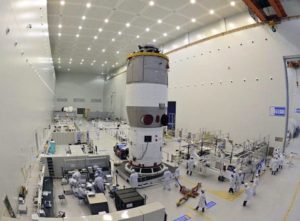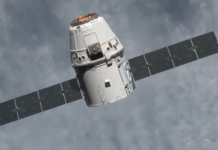
The Chinese space station Tiangong-1, NORAD object 3780, will be reentering the Earth’s atmosphere Sunday, April 1st, with a 24-hour margin of error on either side (http://time.com/5218546/tiangong-falling-space-station-china/). Launched in 2011, it is China’s oldest space station and was intended to be the testing ground for their entire space program. Tiangong translates to “Heavenly Palace.”
Two teams of Chinese astronauts, called taikonauts, have lived on the station in the seven years since its launch, but the station has been abandoned since 2016 when its connection to ground control was broken. China has yet to offer an explanation for the malfunction and can do nothing to control the object’s descent (https://www.vox.com/science-and-health/2018/3/28/17172086/tiangong-1-chinese-space-station-falling-earth-tracking-land).
Weighing 9.3 tons and measuring 34 feet long and 11 feet in diameter, Tiangong-1 is roughly the size of a school bus and will have an unpredictable entry location, and where the debris will fall is even more uncertain. The area ranges across the southern United States, southern Europe, southern Asia, and all of Australia, South America, and Africa. The pieces that will make contact could weigh up to 220 pounds.
Luckily for denizens of Earth, most of the debris will be scorched into dust upon entering the atmosphere. Additionally, water covers 70% of the planet’s surface and much of the land in the space station’s target area is unpopulated. The nonprofit Aerospace Corporation is closely monitoring the situation and says that the odds of a specific person being struck by falling space refuse are less than one in one trillion (http://aerospace.wpengine.netdna-cdn.com/wp-content/uploads/2018/03/COL002.0318_TIAN_2-1.pdf). Their Center for Orbital and Debris Reentry Studies is tracking variation in the atmosphere, the spacecraft’s position and speed, its condition, and its orientation relative to Earth.
This issue is indicative of a larger problem with space debris that will eventually need to be reckoned with. An estimated 170 million pieces of space debris are currently orbiting Earth, and while most are small they could still damage active spacecraft (https://www.washingtonpost.com/news/worldviews/wp/2018/03/29/you-know-that-chinese-satellite-crashing-to-earth-within-days-its-not-alone/?utm_term=.79f979f8d606). If this were to happen, a well-known unit like the International Space Station could meet the same tragic fate as Tiangong-1.










